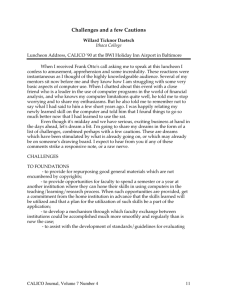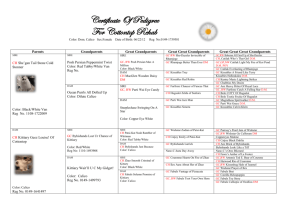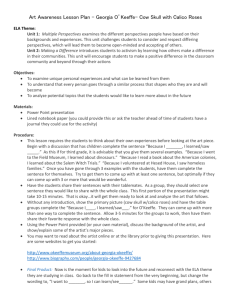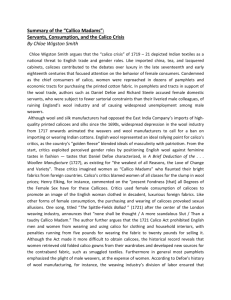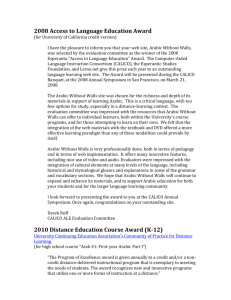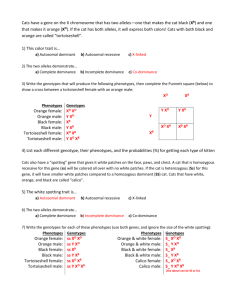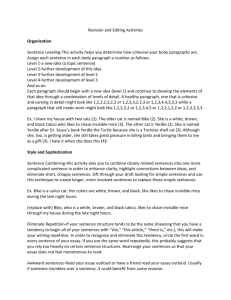Calico Man Made Attributes- Chi Square Goodness
advertisement
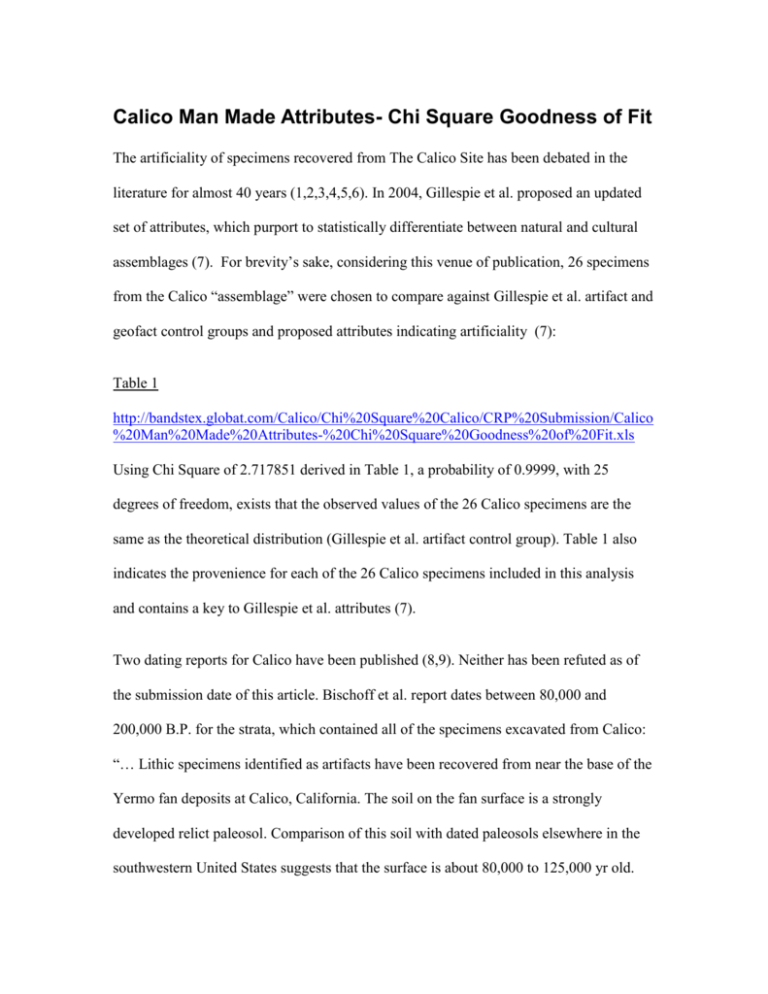
Calico Man Made Attributes- Chi Square Goodness of Fit The artificiality of specimens recovered from The Calico Site has been debated in the literature for almost 40 years (1,2,3,4,5,6). In 2004, Gillespie et al. proposed an updated set of attributes, which purport to statistically differentiate between natural and cultural assemblages (7). For brevity’s sake, considering this venue of publication, 26 specimens from the Calico “assemblage” were chosen to compare against Gillespie et al. artifact and geofact control groups and proposed attributes indicating artificiality (7): Table 1 http://bandstex.globat.com/Calico/Chi%20Square%20Calico/CRP%20Submission/Calico %20Man%20Made%20Attributes-%20Chi%20Square%20Goodness%20of%20Fit.xls Using Chi Square of 2.717851 derived in Table 1, a probability of 0.9999, with 25 degrees of freedom, exists that the observed values of the 26 Calico specimens are the same as the theoretical distribution (Gillespie et al. artifact control group). Table 1 also indicates the provenience for each of the 26 Calico specimens included in this analysis and contains a key to Gillespie et al. attributes (7). Two dating reports for Calico have been published (8,9). Neither has been refuted as of the submission date of this article. Bischoff et al. report dates between 80,000 and 200,000 B.P. for the strata, which contained all of the specimens excavated from Calico: “… Lithic specimens identified as artifacts have been recovered from near the base of the Yermo fan deposits at Calico, California. The soil on the fan surface is a strongly developed relict paleosol. Comparison of this soil with dated paleosols elsewhere in the southwestern United States suggests that the surface is about 80,000 to 125,000 yr old. Clasts near the base of the deposit are well cemented by laminated CaCO3 that probably formed from groundwater action while the fan was still active. Uranium-thorium assays on the CaCO3 indicate an age of 200,000 yr…” (9). Duvall and Venner report: “…In 1970, an international conference…agreed that the deposit was far older than any confirmed archeological site in the Americas but the question of human activity was left unanswered…” (3). Natural, percussive spalling of relatively hard material is known to occur; though it is rare in alluvial and fluvial environments The major force at work in these environments is abrasion, resulting in smoothing and rounding versus percussive breakage (10, 11). Gillespie et al. report: “…High energy processes (e.g., glacial transport, weathering, and colluvial action) may result in macro-alterations, such as flake removals, while low-energy processes (e.g., aeolian, fluvial, and solifluction) can result in striations, pecking, edge flaking, or crushing (Schnurrenberger and Bryan, 1985)…” (7). Given the possibility that the Calico specimens are cultural, utilizing the most current, peer reviewed attributes for statistically differentiating between natural and cultural assemblages (7), a fresh, open minded review of the Calico Site may be in order from the North American archaeological community. Dating of the strata at the site, with the most current techniques, may also be in order. References cited: 1. Archaeological Excavations in the Calico Mountains, California: Preliminary Report L. S. B. Leakey; Ruth De Ette Simpson; Thomas Clements Science, New Series, Vol. 160, No. 3831. (May 31, 1968), pp. 1022-1023. 2. The Calico Site: Artifacts or Geofacts? Vance Haynes Science, New Series, Vol. 181, No. 4097. (Jul. 27, 1973), pp. 305-310. 3. A Statistical Analysis of the Lithics from the Calico Site (SBCM 1500A), California James G. Duvall; William T. Venner Journal of Field Archaeology, Vol. 6, No. 4. (Winter, 1979), pp. 455-462. 4. Criteria for Determining the Attributes of Man-Made Lithics Leland W. Patterson Journal of Field Archaeology, Vol. 10, No. 3. (Autumn, 1983), pp. 297-307. 5. Analysis of Lithic Flakes at the Calico Site, California Leland W. Patterson; Louis V. Hoffman; Rose Marie Higginbotham; Ruth D. Simpson Journal of Field Archaeology, Vol. 14, No. 1. (Spring, 1987), pp. 91-106. 6. Popular Misconceptions Concerning the Calico Site Leland W. Patterson CRP 16 1999, pp 57-60 7. Distinguishing Between Naturally and Culturally Flaked Cobbles: A Test Case from Alberta, Canada Jason David Gillespie, Susan Tupakka, and Christine Cluney Geoarchaeology: An International Journal, Vol. 19, No. 7, 615–633 (2004) 8. A TL/ESR Study of the Hearth Feature at the Calico Archaeological Site, California James L. Bischoff, Motoji Ikeya, Fred E. Budinger, Jr. American Antiquity, Vol. 49, No. 4 (Oct., 1984), pp. 764-774 9. Uranium-series and soil-geomorphic dating of the Calico archaeological site, California James L. Bischoff, Roy J. Shlemon, T. L. Ku, Ruth D. Simpson, Robert J. Rosenbauer, and Fred E. Budinger Geology; December 1981; v. 9; no. 12; p. 576-582 10. Earlier Than You Think A Personal View of Man in America George Carter Texas A&M University Press 1980 pp. 96-102 11. Experimental Abrasion of Pebbles: 2. Rolling by Current P. H. Kuenen 1956
